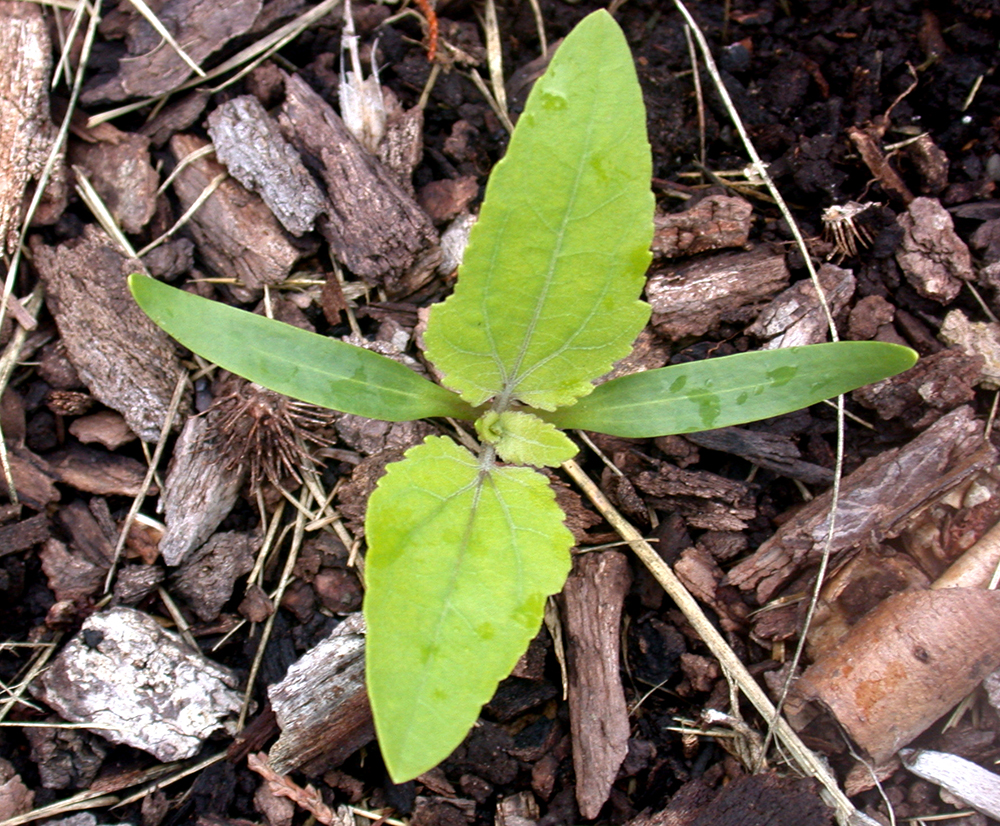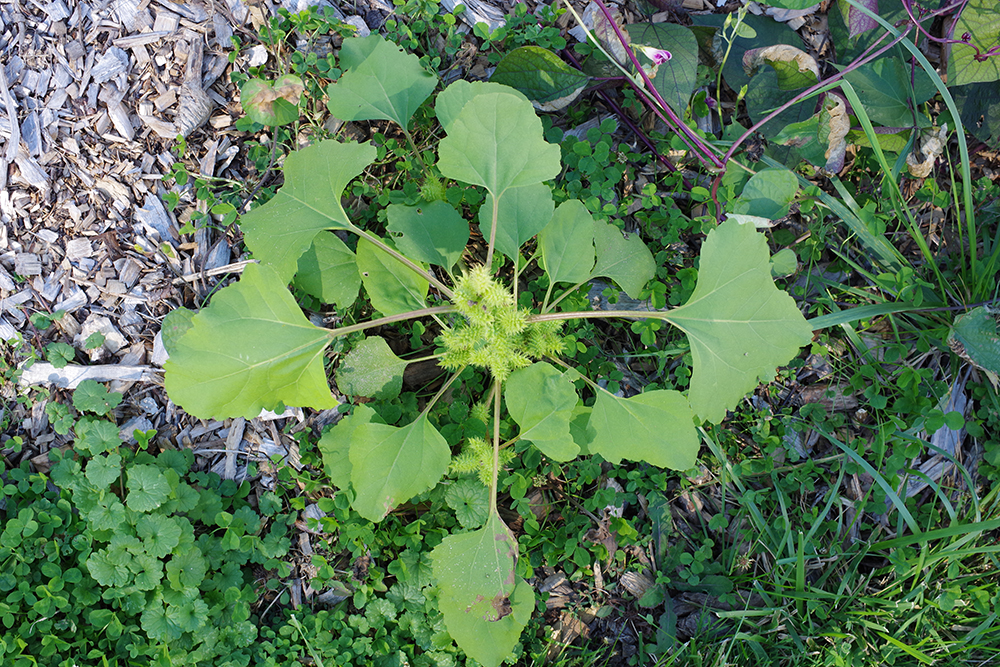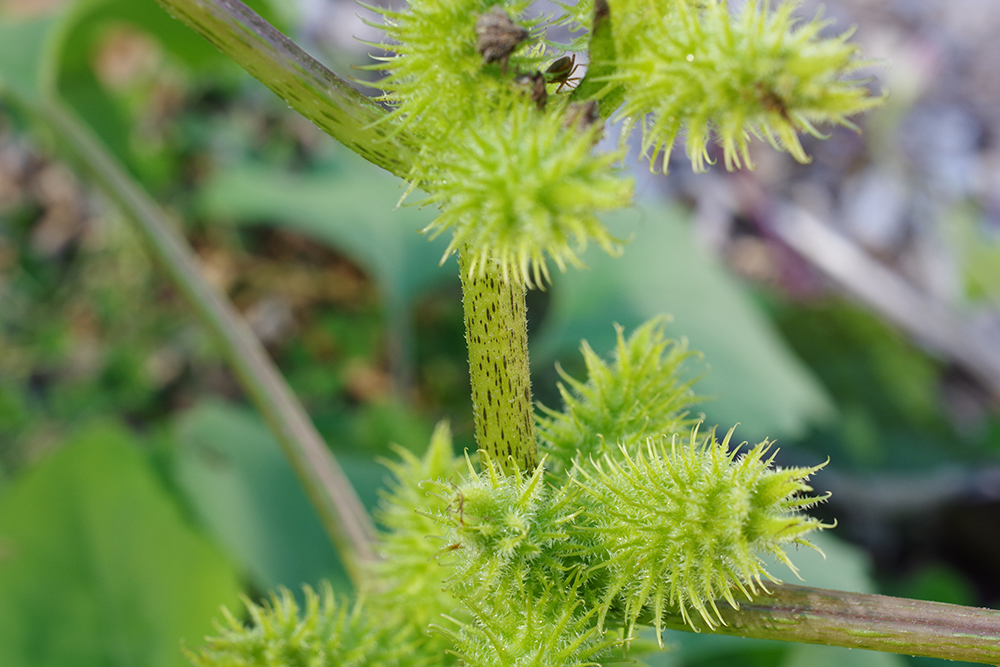Other common names: clotbur, cocklebur, broad-leaved cocklebur, sheep bur, ditch bur, button bur, noogoora bur, heartleaf cocklebur, rough cocklebur



Xanthium strumarium L.
Identification of Cocklebur
Family: Aster family, Asteraceae
Habit: Erect summer annual herb
Description: Seedlings have short, thick stems with purple at the base. Seed leaves are lanceolate, unusually large (2 inches by 0.5 inch) and narrower at each end, hairless, thick, dark green above and light green below. The first pair of true leaves is opposite, triangular to egg shaped with a rounded tip and slightly toothed, with three prominent surface veins. All other young leaves are alternately attached, distinctly toothed, egg shaped with a pointed tip and covered in rough, short hairs. The stem becomes green and covered with upward pointing hairs as the plant develops. Fully mature stems are green, 1–4 feet tall, highly branched, hairy and flecked with purple-brown to black spots. Ridges are present on the stem. Upright hairs cause leaves to feel abrasive and gritty. Leaves are alternate, 1–6 inches long and oval to triangular or heart-shaped. Edges are wavy, irregularly toothed and slightly lobed into three to five sections: the two lobes near the leaf junction with the stalk give the leaf a heart shaped base, and the ones near the leaf tip may be slightly pointed. The leaf stalk is 0.75–3 inches long. The semi-woody, broad and sturdy taproot can reach 4 feet deep. Heads of either all male or all female green flowers appear in leaf axils near branch tips, but both sexes occur on the same plant. Individual flowers are inconspicuous. Male heads are 0.2–0.3 inch across and are subtended by one to three rows of small green bracts. Individual male flowers are round and short-lived, dropping off after shedding pollen. Female flowers are contained within small, green, immature burs. Fruit is a woody, brown, egg shaped to elliptical bur. Each bur is approximately 1 inch long by 0.7 inch or less wide, is covered in hard 0.1–0.25 inch spines and has two beaklike projections at the tip. Each bur contains two oblong, pointed, light brown to black seeds, covered in a papery, silver-black membrane. Each bur contains one large and one small seed, 0.31–0.60 inch long by 0.2–0.3 inch wide.
Similar species: Four species are sometimes mistaken for common cocklebur: jimsonweed (Datura stramonium L.), spiny cocklebur (Xanthium spinosum L.), common burdock (Arctium minus Bernh.) and great burdock (Arctium lappa L.). Jimsonweed can be confused for cocklebur at the seedling stage but can be distinguished by its hairless stems, singly veined leaves and unpleasant odor. Spiny cocklebur has yellow spines at the leaf nodes, more slender leaves and beakless burs. Common burdock and great burdock also produce burs but have larger (20 inches by 16 inches) leaves and burs that break into individual, spined fruits.
Management of Cocklebur
Common cocklebur is an extremely competitive weed due to fast emergence and rapid growth supported by the large seed. Populations of one to three plants per 10 square feet can cause soybean yield losses of 52–75%. Common cocklebur emerges faster and in higher numbers, and it is more competitive under tillage than no-tillage conditions, so no-tillage grain production will be less favorable to this weed. Tine weeding and rotary hoeing have limited effectiveness because the seedlings can emerge from deep in the soil. Cultivate row crops early and close to the row, and repeat regularly until the crop is too large to tolerate tractor traffic. If plants set seed before harvest, collect or destroy the seeds during combining.
Because the seeds do not persist well in the soil, rotation to a sod crop for several years will help control this weed. Rotation to a winter grain will also help because the burs do not mature by grain harvest. Disk the field and plant a cover crop after grain harvest to prevent resprouting from the shoot bases and subsequent seed production.
Soil solarization so that mid-day soil temperatures reach 149–156°F will eliminate a high proportion of common cocklebur seeds.
Common cocklebur often establishes first on unmanaged areas like railroad embankments and stream banks, so if you see it there, eradicate it quickly before it can invade your tilled fields.
Ecology of Cocklebur
Origin and distribution: Common cocklebur is probably native to North, Central and South America, and possibly also to southern Europe and South Asia. It occurs in Africa and has been introduced into Australia. Its natural habitat is along riverbanks and beaches, and more recently it has colonized agricultural fields, roadsides and other disturbed habitats.
Seed weight: small (upper) seed, 50 mg; large (lower) seed, 60–75 mg. Burs can vary considerably in size. A large proportion of small and intermediate sized burs have either no seeds or only one seed.
Dormancy and germination: Burs usually contain two seeds, and these differ in size and dormancy. The smaller (upper) seed often sits closer to the tip of the bur and is usually dormant. The larger (lower) seed usually germinates the next spring following an after-ripening period. The smaller seed usually does not germinate until summer or the following year; this dormancy is apparently due to germination inhibitors in the seed coat and inability of oxygen to pass through the seed coat. Germination of both types of seeds is promoted by microbial decay or mechanical seed coat damage. The seeds do not require light for germination. A daily temperature fluctuation of 27°F increased germination over that at constant temperatures. Germination was greatest with warm, fluctuating temperatures of 86/68°F to 91/77°F. Under a constant temperature regime, highest germination occurred at 95–104°F, but constant soil temperatures of this magnitude are unlikely to occur under natural field conditions.
Seed longevity: Based on measurements at six to 30 months, common cocklebur seed viability declines at about 50% per year. In Arkansas, no common cocklebur seeds were viable three years after being shed. In Nebraska, some seeds buried in plastic capsules survived for 9 years.
Season of emergence: Most emergence occurs in mid-spring to early summer, with occasional pulses of seedlings appearing later in the summer as well. Emergence is dispersed more evenly from late spring throughout summer under no-till than under tilled conditions. The lowest average soil temperature required for emergence was 63°F, and the minimum day/night soil temperature fluctuation required for emergence was 14°F.
Emergence depth: Common cocklebur emerges well from 0.4-4 inches of soil, and a few seedlings can emerge from as deep as 6 inches. Seeds usually cannot take up enough water to germinate when they are on the soil surface due to poor contact between the large seeds and soil.
Photosynthetic pathway: C3
Sensitivity to frost: Common cocklebur tolerates only light frost.
Drought tolerance: Common cocklebur is drought tolerant. Roots can extend 7 feet laterally and 4 feet deep, allowing access to water throughout the soil profile. Common cocklebur is an aggressive competitor partially because of its capacity to take up more water than other crops or weeds under similar growth conditions. It can maintain photosynthesis and transpiration under drought stress better than soybeans, but its growth and reproduction are, nonetheless, reduced by prolonged drought.
Mycorrhiza: Common cocklebur is considered a strong mycorrhizal host.
Response to fertility: Common cocklebur is highly responsive to N. In high N conditions, it will store excess N as nitrate and later use it to increase seed production. It grows well at pH 5.2–8.
Soil physical requirements: The species grows in a wide range of soil types from coarse sand to heavy clay. It can tolerate flooded as well as dry soil conditions.
Response to shade: Shade reduces growth and delays flowering of common cocklebur. In the absence of root competition, shade from a soybean leaf canopy reduced cocklebur water uptake, leaf area and weight. Cocklebur has the capacity to maintain functionality of lower leaves within the shade of a crop canopy by adjusting leaf metabolism accordingly. It also has the potential to alter upper leaf growth to increase light capture in response to reduced light levels on lower leaves.
Sensitivity to disturbance: Very rapid growth and ability to emerge from deep layers in the soil make common cocklebur insensitive to tine weeding and rotary hoeing. Small plants regrow quickly from buds at the base of lower leaves if plants are trampled or clipped. Once flowers have been pollinated, the burs will produce mature seeds even if the shoot or branch is severed from the roots.
Time from emergence to reproduction: Plants flower as days shorten, and generally flowering begins in August regardless of age or size. Seed maturation continues until a killing frost. Flowering initiated 16 weeks after emergence in Arkansas and Wisconsin, but 10 weeks after emergence in Quebec. Seeds become viable early in development. A few seeds are viable when burs begin to form, and the majority are viable when burs are fully elongated about three weeks later. In India, time from appearance of first flowers to ripening of first fruit was 23 days.
Pollination: Common cocklebur primarily self-pollinates, but up to 12% of flowers are cross pollinated by wind dispersed pollen.
Reproduction: Vigorous, open grown plants produce 500–5,400 burs, each of which usually contains two seeds. However, in dense stands, plants produced only 71–586 burs per plant. In pure stands in Arkansas, individual plants produced 4,500 burs (9,000 seeds), whereas in Quebec, plants produced 1,300–3,500 seeds. Individual cocklebur plants produced 900 burs (1,800 seeds) when grown with soybeans in North Carolina. The number of burs depends entirely on the size of the plant at the time flowering begins.
Dispersal: The spiny burs cling to animal fur, clothing, grain sacks, etc. They tangle particularly well in sheep's wool and are dispersed when the animals or wool are transported. The burs float well and are readily dispersed in streams, lakes, irrigation ditches and flooded fields.
Common natural enemies: The moth, Phaneta imbridana, lays eggs on the bur wall, and the larvae bore in and eat the seeds. The fly, Euaresta aequalis, pierces the bur wall and lays its eggs directly on the developing seeds. Together these insects killed from 3–84% of the seeds in New York. Population variation in bur characteristics greatly affects seed mortality, with long spines inhibiting the fly and thick bur walls inhibiting the moth. Two stem beetles burrow down through the stem and overwinter in the root, but they only affect seed set in the branches that they actually damage. The rust Puccinia xanthii is common in the United States and affects only cocklebur and ragweed species. It causes deformed leaves, early leaf drop, cracks on the stem, reduced plant size and reduced seed viability. Spores overwinter on dead plants, which offers some possibility for deliberately spreading the disease using powdered diseased plants.
Palatability: People do not consume common cocklebur, but the seeds have been used in herbal medicine. The cotyledons are highly toxic to livestock. Larger plants have good nutritional value for livestock but are rough and unpalatable. Common cocklebur was unpalatable to grazing sheep.
Note: The pollen of cocklebur produces hay fever symptoms in sensitive individuals, and contact with the stems can also cause dermatitis in some individuals.
Summary Table of Cocklebur Characteristics
The following table summarizes the characteristics of the weed species.
| Common Cocklebur | ||||||||
|---|---|---|---|---|---|---|---|---|
| Growth habitat | Seed weight (mg) | Seed dormancy at shedding | Factors breaking dormancy | Optimum temperature for germination (F) | Seed mortality in untilled soil (%/year) | Seed mortality in tilled soil (%/year) | Typical emergence | Optimum emergence depth (inches) |
| tall, erect | 50–75 | variable | scd, at | 86/68–91/77 | 50 | – | mid spring to early summer | 0.4–4 |
| Photosynthesis type | Frost tolerance | Drought tolerance | Mycorrhiza | Response to nutrients | Emergence to flowering (weeks) | Flowering to viable seed (weeks) | Pollination | Typical & high seed production (seeds per plant) |
| C3 | low | high | yes | high | 10–16 | 3–4 | self, can cross | 1,800 & 10,000 |
Table Key
General: The designation “–” signifies that data is not available or the category is not applicable.
Growth habit: A two-word description; the first word indicates relative height (tall, medium, short, prostrate) and second word indicates degree of branching (erect, branching, vining).
Seed weight: Range of reported values in units of “mg per seed.”
Seed dormancy at shedding: “Yes” if most seeds are dormant when shed, “Variable” if dormancy is highly variable, “No” if most seeds are not dormant.
Factors breaking dormancy: The principle factors that are reported to break dormancy and facilitate germination. The order of listing does not imply order of importance. Abbreviations are:
scd = seed coat deterioration
cms = a period subjected to cold, moist soil conditions
wst = warm soil temperatures
li = light
at = alternating day-night temperatures
ni = nitrates
Optimum temperature range for germination: Temperature (Fahrenheit) range that provides for optimum germination of non-dormant seeds. Germination at lower percentages can occur outside of this range. The dash refers to temperature range, and the slash refers to alternating day/night temperature amplitudes.
Seed mortality in untilled soil: Range of mortality estimates (percentage of seed mortality in one year) for buried seeds in untilled soil. Values were chosen where possible for seeds placed at depths below the emergence depth for the species and left undisturbed until assessment. Mortality primarily represents seed deterioration in soil.
Seed mortality in tilled soil: Range of mortality estimates (percentage of seed mortality in one year) for seeds in tilled soil. Values were chosen for seeds placed within the tillage depth and subjected to at least annual tillage events. Seed losses are the result of dormancy-breaking cues induced by tillage, germination and deterioration of un-germinated seeds.
Typical emergence season: Time of year when most emergence occurs in the typical regions of occurrence for each weed. Some emergence may occur outside of this range.
Optimum emergence depth: Soil depths (in inches below the soil surface) from which most seedlings emerge. Lower rates of emergence usually will occur at depths just above or just below this range.
Photosynthesis type: Codes “C3” or “C4” refer to the metabolic pathway for fixing carbon dioxide during photosynthesis. Generally, C3 plants function better in cooler seasons or environments and C4 plants function better in warmer seasons or environments.
Frost tolerance: Relative tolerance of plants to freezing temperatures (high, moderate, low).
Drought tolerance: Relative tolerance of plants to drought (high, moderate, low).
Mycorrhiza: Presence of mycorrhizal fungi. “Yes” if present; “no” if documented not to be present, “unclear” if there are reports of both presence and absence; “variable” if the weed can function either with or without, depending on the soil environment.
Response to nutrients: Relative plant growth response to the nutrient content of soil, primarily N, P, K (high, moderate, low).
Emergence to flowering: Length of time (weeks) after emergence for plants to begin flowering given typical emergence in the region of occurrence. For species emerging in fall, “emergence to flowering” means time from resumption of growth in spring to first flowering.
Flowering to viable seed: Length of time (weeks) after flowering for seeds to become viable.
Pollination: “Self” refers to species that exclusively self-pollinate, “cross” refers to species that exclusively cross-pollinate, “self, can cross” refer to species that primarily self-pollinate, but also cross-pollinate at a low rate, and “both” refers to species that both self-pollinate and cross-pollinate at relatively similar rates.
Typical and high seed production potential: The first value is seed production (seeds per plant) under typical conditions with crop and weed competition. The second value, high seed production, refers to conditions of low density without crop competition. Numbers are rounded off to a magnitude that is representative of often highly variable reported values.
Further Reading
Bararpour, M.T. and L.R. Oliver. 1998. Effect of tillage and interference on common cocklebur (Xanthium strumarium) and sicklepod (Senna obtusifolia) population, seed production, and seed bank. Weed Science 46: 424–431.
Norsworthy, J.K. and M.J. Oliveira. 2007c. Tillage and soybean canopy effects on common cocklebur (Xanthium strumarium) emergence. Weed Science 55: 474–480.
Weaver, S.E. and M.J. Lechowicz. 1982. The biology of Canadian weeds. 56. Xanthium strumarium L. Canadian Journal of Plant Science 63: 211–225.

